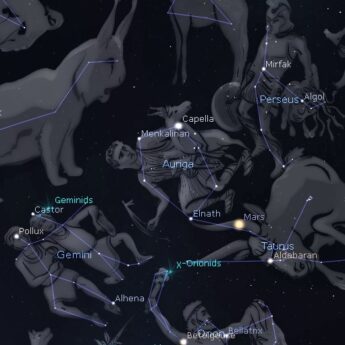This Week’s Sky at a Glance, 2022 December 10 – December 17 ~ By Curt Nason
Evening stargazing can be tricky this time of year with all the festive lights, especially if you have a neighbourhood Griswald. If you happen to be out, try identifying a few constellations. In the northeast there is pentagonal Auriga the Charioteer, with bright Capella the Goat Star at one corner. To the right is the V-shaped face of Taurus the Bull, with the dipper-like star cluster of the Pleiades marking its shoulder and Mars currently residing within its horns. Orion and Gemini follow below Taurus and Auriga. Above Auriga is Perseus, seemingly standing on the bull’s back. It is here a patient stargazer can watch a marvel of the night sky.
In mythology, Perseus beheaded Medusa and used her snaky head to seek revenge on tormentors by turning them to stone. The second brightest star in the constellation Perseus represents the evil eye of Medusa and it is called Algol, the ghoul or demon. There is a reason for this name. Every three days, minus about three hours, this star slowly dims by a factor of three and regains brightness over several hours. Algol is an eclipsing binary, two stars orbiting each other closely and aligned to our line of sight. When the smaller, dimmer star passes in front of the brighter one we can see the stars’ light diminish and recover. By comparing it with nearby stars of similar brightness you might notice Algol dimming and getting brighter. Our next convenient evening opportunity to watch this is on Monday, when Algol is dimmest around 10:30 pm.
This Week in the Solar System
Saturday’s sunrise in Moncton is at 7:50 am and sunset will occur at 4:33 pm, giving 8 hours, 43 minutes of daylight (7:52 am and 4:41 pm in Saint John). Next Saturday the Sun will rise at 7:56 am and set at 4:34 pm, giving 8 hours, 38 minutes of daylight (7:58 am and 4:42 pm in Saint John).
The Moon is at third quarter on Friday, December 16, rising before midnight on Thursday and setting before 1 pm. Mars is highest around midnight and it will gradually appear smaller in telescopes over the next two months. Saturn is seen best in the early evening, while Jupiter is at its highest around 7 pm. Telescope users might see Jupiter’s Red Spot around 7:30 on Monday and 9 pm Wednesday. The solar system highlight will be the reliable Geminid meteor shower, which peaks over Wednesday night but should be fairly active the night before and after. The waning gibbous Moon will reduce morning observing success but there should be plenty of bright meteors to make braving the chill worthwhile.
On Sunday evening at 8 pm, tune in to the Sunday Night Astronomy Show via the Facebook page or YouTube channel of Astronomy by the Bay.
Questions? Contact Curt Nason.

